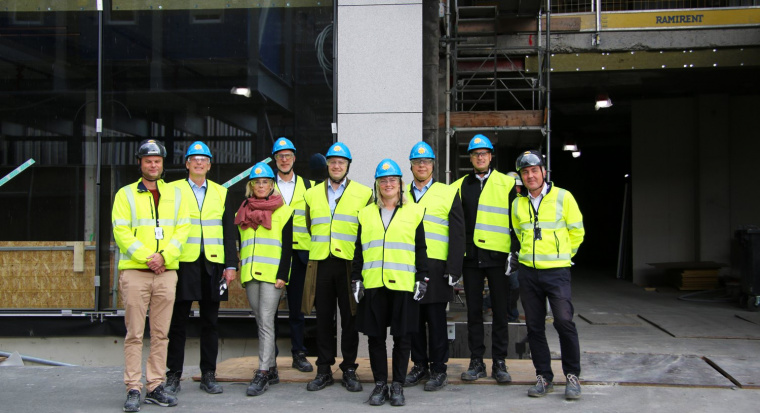NIB’s green investors leave their desks to experience the projects they finance

Earlier this autumn, NIB invited investors in the Bank’s environmental bonds to get to know some of the projects they helped finance in Stockholm. The meeting included visits to Henriksdal, the world’s largest underground wastewater treatment plant, and Vasakronan’s green complex Sergelhuset, which is aiming to attain the highest LEED certification possible for sustainable buildings.
“It’s a great chance to witness what our investments actually contribute to in the real world,” says Sarah Olofsson, Responsible Investments Manager at Swedbank Robur. “When making sustainable investments, it is always nice to see the results. It makes the impact of the investment more tangible.”
Helena Lindahl, Senior Portfolio Manager at Storebrand, agrees: “We participate in these events to get a deeper understanding of the environmental projects we invest in. It is valuable to visit a real project site every once in a while, rather than just study it on your screen.”
NIB issues environmental bonds to reach out to investors with a strong interest in financing a sustainable future. The Bank allocates the funds from NIB Environmental Bonds (NEBs) to carefully selected projects that bring significant environmental benefits. The information on environmental bonds, NEB-financed projects, and their eligibility criteria is regularly updated on NIB’s website.
“As an issuer, we commit to providing NIB’s environmental investors with transparent information on the use of proceeds of our Environmental Bonds. And what better way to demonstrate how the funds have been used than taking the investors to see the projects themselves”, says Angela Brusas, Senior Funding Manager at NIB.
Henriksdal Underground Wastewater Treatment Plant
Henriksdal wastewater treatment plant’s (WWTP) expansion is funded by two loans from NIB, totalling SEK 4,500 million (EUR 479 million). Both of the facilities are fully financed by NEB proceeds.
The project included the construction of 15-kilometre sewer tunnel under the southern-central part of Stockholm, and other infrastructure improvements that doubled the wastewater treatment capacity to more than 500,000 cubic metres per day. As a result, Henriksdal WWTP became the world’s largest underground facility of its kind, as well as the largest facility for membrane bioreactor technology used in wastewater treatment operations.
Magnus Andersson, Senior Environmental Analyst at NIB, says the expansion and upgrading of Stockholm’s main WWTP is the perfect example of projects that are fully in line with the Bank’s mission. “The developments at Henriksdal’s WWTP both improve productivity and benefit the environment. Although larger volumes of wastewater are to be treated, the project reduces the absolute discharges of phosphorus and nitrogen, combatting eutrophication of the Baltic Sea.”
“The most interesting thing of visiting Henriksdal was to gain insight in how an enormous infrastructural project is created right beneath our feet, and most people are totally unaware of it,” comments Helena Lindahl, who was curious to learn about the project not only as an investor, but also as a resident of the Swedish capital.
Another Stockholm local shared a similar view. “The visit to WWTP was something very far from our everyday life, yet also completely connected to it, since it revolved around the wastewater of the city we reside in. For someone who enjoys living next to the Baltic Sea, it felt good to see a facility that supports the growth of our city and improves marine life in its immediate surroundings,” says Thomas Bäck, Senior Portfolio Manager at Swedbank Robur.
Vasakronan’s Sergelhuset
NIB’s SEK 2,345 million (EUR 248 million) loan to Vasakronan for the renovation and construction of green buildings in Stockholm and Gothenburg is also financed by NEB proceeds. NIB’s green investors had the chance to visit the construction site of Sergelhuset. The complex located in the heart of Stockholm will have 85,000 square metres of floor area, combining offices, shops and apartments after the renovation is completed by the end of 2020.
“Getting a loan from NIB is a confirmation that we have high ambitions when it comes to sustainability, as the Bank has strict criteria when selecting projects to finance. By arranging a site visit, we get an opportunity to show our projects to the Bank and its investors. It also allows the people working on the project to discuss the progress directly with the financiers, and this creates pride,” says Thomas Nystedt, Group Treasurer at Vasakronan.
 Visiting Sergelhuset construction site
Visiting Sergelhuset construction site
There is indeed something to be proud of about Sergelhuset, as the complex is to receive Platinum status under the Leadership in Energy and Environmental Design (LEED) certification system. LEED certification is the most widely used green building rating system in the world, promoting cost-saving and resource efficient construction solutions.
“Given the long lifetime of new buildings, it is essential to make efforts in reducing its potential negative impacts. Applying the highest certification level of LEED ensures that the negative effects on the environment are minimised not only in terms of climate related issues, but also in terms of local and regional impacts. These include water and waste management, site and ecology, transportation or pollution – all of which are equally important in NIB’s view,” says Magnus Andersson.
After the visit, Sarah Olofsson summed up the day from the investors’ perspective. “Whilst participating in these events is always interesting on a personal level as we learn about things we might not face in our everyday life, study visits connected to our investments might also be viewed as sort of a ‘due diligence’.
NIB has well-established processes to choose projects to support through sustainable bonds, and reporting on their impact is a given for them, but it feels good to leave our desks for a while and see the projects with our own eyes.”
NIB Environmental Bond Framework
NIB Environmental Bond Report 2018